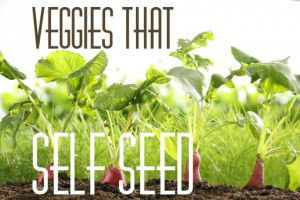
Whether you’re a lazy gardener or you just don’t have a lot of time on your hands (and who does?) self-seeding, self-sowing vegetables can be the perfect solution you’ve been looking for to grow your own organic vegetables. You probably knew that perennial flowers self-seed and return again and again, but the same is true for many other crops, including those you can eat!
To take advantage of self-seeding you can just let your plants go to seed, and create a stalk that develops flowers and later seeds that naturally drop into the area around the plant. Some will also scatter in the wind, so they can end up in unexpected areas (if you’re looking for organization this is a downside).
A benefit of self-seeding is that crops going to flower is a great way to attract insects and birds that are good for your garden, making it more sustainable and more diverse. It also helps keep the soil fresh with nutrients and free from weeds.
You can also let the plants go to seed and then cut the seed head carefully to strategically scatter the seeds where you’d like them to be, or save the seeds for next year. Or, you can even use a little of both methods if you’d like.
Some of the best self-seeding edibles include:
Beans. Beans can be left to germinate in the spring.
Tomatoes. You have to be careful with tomatoes, as they are quite promiscuous. They tend to reseed and re-sow prolifically.
Carrots. There are a number of varieties of carrots that will self-seed, germinating in the fall and spring.
Garlic. All you have to do is leave a bulb in the ground at harvest time, and more garlic will grow (though splitting them will have the advantage of providing more ‘room’ for each garlic plant, since each clove in the bulb represents a new plant).
Leeks. Self-sowing leeks form a clump of very small and tender leeks that can be eaten from top to bottom.
Lettuce. Several types of lettuce varieties, including red and green mignonette as well as oak leaf, will thrive year round. Once two or three crops go to seed, you’ll start to have them all year round (assuming you have very mild winters).
Potatoes. You don’t need to dig a deep hole for potatoes, just bury them under some mulch. Take what you need and let the rest regrow for year round potatoes.
Pumpkin. Pumpkins allowed to rot in the garden will provide seeds that germinate in the spring.
 Radish. Radishes are one of the easiest vegetables to grow. They also self-sow very easily, almost too much in some cases. Keep in mind that radishes become hotter the older they get.
Radish. Radishes are one of the easiest vegetables to grow. They also self-sow very easily, almost too much in some cases. Keep in mind that radishes become hotter the older they get.
There are also self-seeding herbs that not only offer a wonderful way to spice up your meals, they contain lots of health benefits as well. Consider herbs such as cilantro, dill, parsley, oregano, chives, chamomile and basil.
You now have one less excuse not to grow and enjoy your own organic garden!
-The Alternative Daily
Source:
http://www.care2.com/greenliving/the-lazy-gardener-self-seeding.html

